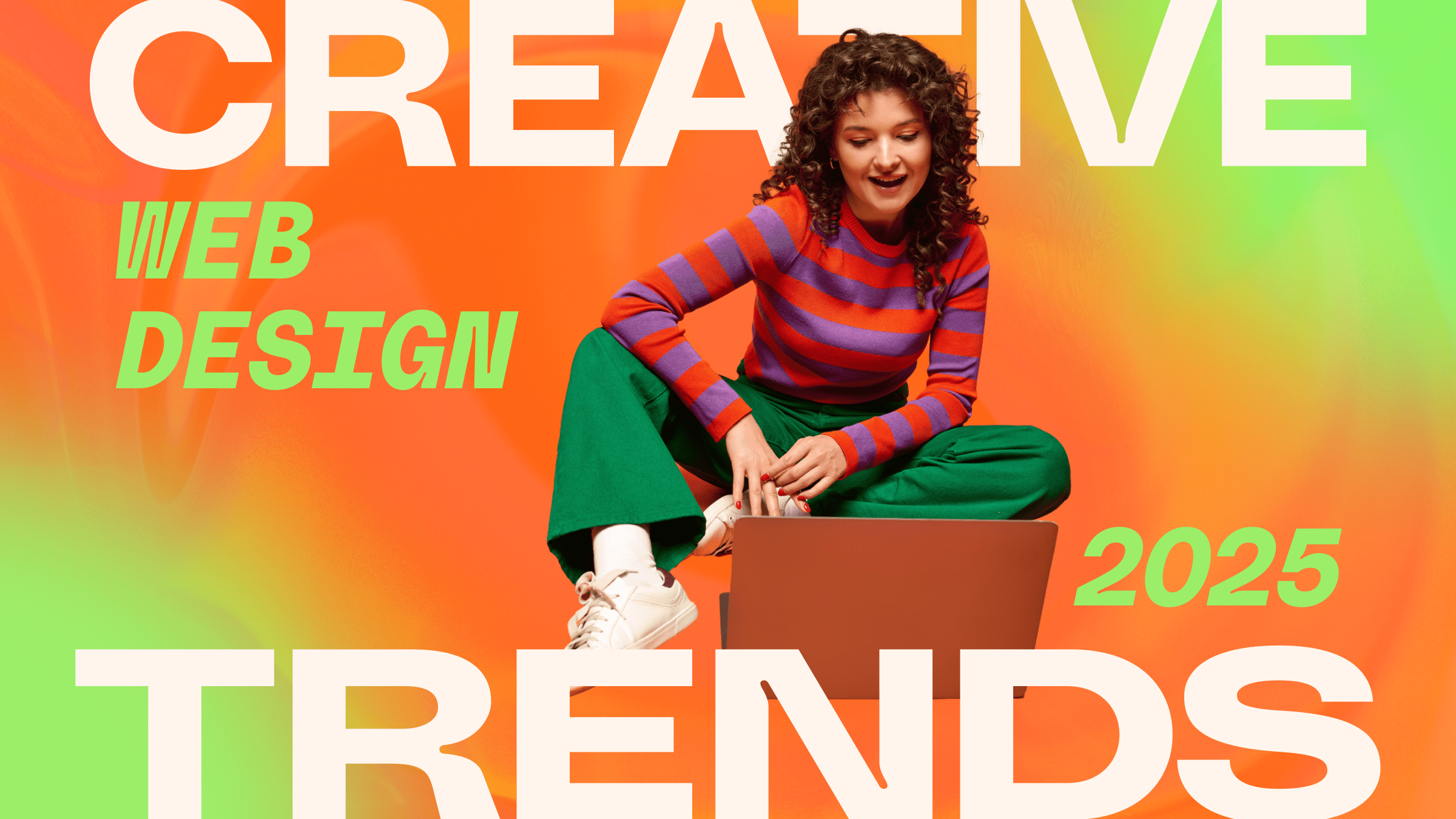Professional insights on creating engaging visuals from an agency for web design
Checking Out Creative Trends in Web Design for Modern Businesses
The landscape of web design is continually developing, mirroring the vibrant needs of modern-day organizations. Current trends highlight a preference for minimalism, strong typography, and engaging interactivity. Business significantly focus on user experience via mobile-first concepts and personalized web content. In addition, a concentrate on sustainability is gaining grip. Comprehending these patterns is important for services aiming to stand apart in a jampacked market. What ramifications do these changes hold for the future of digital interaction?
Accepting Bold Typography
Strong typography has arised as a defining component in modern web design, recording attention and sharing messages with striking clarity. This pattern focuses on visually impactful message that boosts user involvement and brand identification. Developers commonly make use of unique typefaces and oversized font styles to develop a pecking order, assisting viewers through content flawlessly.
The critical usage of bold typography enables effective narration, making it possible for brands to interact their worths succinctly. It serves not just visual objectives yet additionally functional ones, as it enhances readability across gadgets and screen sizes.
As internet sites compete for user attention, strong typography stands out in a saturated electronic landscape. Its versatility enables designers to experiment with contrasting shades and designs, additionally amplifying its efficiency. Eventually, accepting vibrant typography stands for a shift in the direction of even more communicative and meaningful web design, cultivating a deeper link in between brand names and their target markets.
The Increase of Minimalist Layout
As digital atmospheres come to be significantly chaotic, the rise of minimalist layout offers a renewing choice that focuses on simpleness and capability. This design ideology strips away unnecessary aspects, permitting material to take spotlight. By concentrating on clean lines, enough white space, and a limited shade palette, minimalist style enhances user experience and boosts navigation.
Organizations adopting this trend aim to communicate their brand name message clearly and efficiently, cultivating a feeling of calmness and quality. The absence of interruptions assists customers focus on important info, leading to improved involvement and conversion prices. Additionally, minimal design aligns well with mobile-first methods, ensuring that web sites stay easy to use and accessible across various gadgets.
Inevitably, the surge of minimal design mirrors a wider change in the direction of prioritizing user requirements and choices, making it a powerful tool for modern businesses wanting to make an enduring influence in the digital landscape.
Immersive Animations and Interactivity
While numerous web developers welcome minimalist aesthetics, another engaging trend obtaining traction is using immersive animations and interactivity. This technique boosts user interaction by creating interesting experiences that attract visitors into the material. Developers use dynamic elements such as animated histories, scrolling effects, and interactive infographics to communicate complex ideas in an easily accessible way.
These animations not just supply aesthetic interest but also guide users with the navigating process, making communications a lot more user-friendly. Hover impacts and animated shifts can encourage individuals to check out even more, leading to increased time invested on the site.
This pattern straightens with the wider motion in the direction of narration in internet style, where computer animations offer as narrative gadgets that share brand name messages successfully. By integrating immersive animations and interactivity, businesses can differentiate themselves in a jampacked online landscape, ultimately enhancing user complete satisfaction and brand loyalty.
Mobile-First Design Concepts
Mobile-first layout concepts highlight focusing on user experience by ensuring websites function seamlessly on smaller sized screens. This technique integrates receptive design techniques that adapt to numerous device sizes while preserving aesthetic stability. Furthermore, it focuses on touchscreen navigation design, improving usability for mobile users.
Prioritizing User Experience
Just how can developers efficiently focus on user experience in a significantly mobile-centric globe? Highlighting mobile-first layout concepts is vital, as customers mainly engage with sites with mobile gadgets. This strategy urges developers to improve web content, guaranteeing it is easily obtainable and accessible on smaller sized displays. Key practices include simplifying navigation, minimizing load times, and employing touch-friendly components that enhance interactivity. Furthermore, focusing on clear typography and instinctive layouts can greatly enhance user fulfillment. Developers must continuously gather user feedback to refine their strategies, adjusting to developing user demands and choices. By concentrating on these elements, organizations can develop an interesting digital experience that fosters commitment and drives conversions, eventually aligning with the expectations of today's mobile users.
Receptive Layout Methods
Developers accept receptive layout strategies to produce flexible and adaptive web experiences that satisfy numerous display dimensions. This technique focuses on mobile-first design concepts, making certain peak capability on smaller devices before scaling up for larger displays. By making use of liquid grids, versatile pictures, and media questions, developers can keep a natural visual identification throughout all systems. This technique not just improves user engagement yet also improves search engine rankings, as mobile-friendly websites are preferred by search algorithms. Additionally, receptive formats allow services to get to a more comprehensive target market, accommodating individuals on smartphones, desktop computers, and tablet computers alike. Generally, implementing these methods is essential for modern web design, making sure that businesses remain affordable in an ever-evolving electronic landscape.
Touchscreen Navigation Style
With the increase of mobile phones, touchscreen navigation has come to be an essential element of web design. Developers are significantly adopting mobile-first principles to boost user experience and interaction. Web Design Agency. Reliable touchscreen navigation prioritizes larger switches and intuitive gestures, allowing users to interact easily with material. This method minimizes frustration and encourages exploration, as users can browse perfectly with their fingers. Furthermore, incorporating swipe my blog gestures and faucet capability satisfies the all-natural habits of mobile users. Feedback mechanisms, such as visual signs and computer animations, improve use additionally by verifying actions. As touchscreens control user communications, utilizing these layout elements not only aligns with modern-day expectations however also fosters a more obtainable and delightful surfing experience for all users
Customized User Experiences
What makes a user really feel really engaged on an internet site? The answer usually hinges on customized user experiences. By tailoring web content and navigating to private preferences, companies can develop a purposeful connection with their audience. This personalization can be accomplished with numerous techniques, such as evaluating user habits, making use of cookies, and providing customized referrals based on previous communications.
As an example, ecommerce platforms that recommend products based on browsing background not only boost user experience yet also raise conversion prices. Integrating vibrant content that adjusts to the user's area or time of day can further enrich engagement.
Furthermore, customized introductions or messages can make customers really feel valued and recognized. As modern-day services seek to attract attention in a competitive digital landscape, accepting tailored user experiences comes to be essential, promoting commitment and motivating repeat visits. Inevitably, this approach transforms a standard website right into an interactive platform that reverberates with its audience.
Sustainability in Web Design
As the digital landscape proceeds to advance, the relevance of sustainability in web design has actually gotten significant attention. Designers are significantly familiar with the ecological impact their creations can have, motivating a change in the direction of environment-friendly methods (Web Design Agency). Sustainable web design concentrates on enhancing sites to decrease energy intake and carbon impacts. Techniques include utilizing minimalistic layout concepts, enhancing pictures, and utilizing efficient coding methods to boost loading rates
The selection of holding suppliers plays a necessary role; lots of designers are currently opting for environment-friendly holding services powered by sustainable energy. By focusing on access and easy to use navigating, sustainable styles additionally provide to a broader target market, boosting use. This aware method not just charms to environmentally-minded visit their website customers yet likewise contributes to the total durability and efficiency of sites. Inevitably, sustainability in web design shows an expanding trend in the direction of accountable electronic practices that align with modern company worths.

Regularly Asked Concerns
How Can I Select the Right Shade Plan for My Site?
To pick the right color scheme for a web site, one ought to consider the brand's identity, target market, and emotional effect. Using shade concept and screening mixes can boost user experience and aesthetic appeal considerably.
What Are the Finest Tools for Prototyping Website Design?
The best tools for prototyping website design include Figma, Sketch, Adobe XD, and InVision. These platforms provide intuitive interfaces, cooperation attributes, and comprehensive libraries, making them excellent for designers to develop and fine-tune their principles effectively.
Just how Do I Determine the Performance of My Web Design?
To measure web design effectiveness, one ought to examine user involvement metrics, conversion rates, and use responses (Web Design Agency). A/B testing and heatmaps can also give understandings right into user actions, directing necessary modifications for enhanced efficiency and user experience
What Are Common Web Design Blunders to Prevent?
Common web design mistakes include chaotic moved here layouts, inadequate navigation, slow-moving loading times, lack of mobile optimization, inadequate comparison, and disregarding user responses. Avoiding these challenges boosts user experience and boosts total performance of the website.
Exactly how Frequently Should I Update My Site Layout?
A web site design need to be updated every 2 to 3 years, or quicker if substantial changes in branding or technology happen. Normal updates maintain the website fresh, useful, and aligned with present user expectations.
